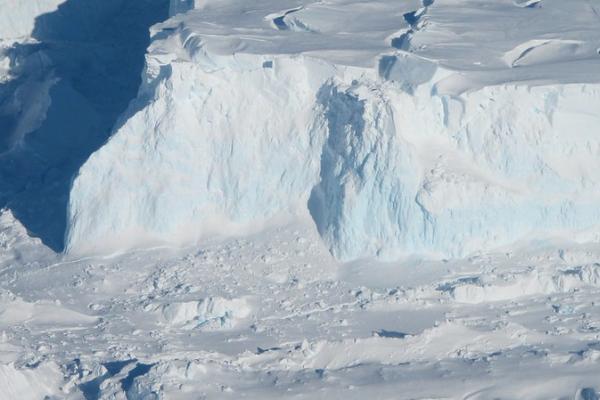Accelerated Thinning and Retreat at Thwaites Glacier Due to Ice-Shelf Channel Intersections at Grounding Zones

ORIGINALLY POSTED BY BYRD POLAR AND CLIMATE RESEARCH CENTER
Last month, the European Geosciences Union's (EGU's) The Cryosphere published a study investigating the interaction between ice-shelf channels and the grounding zone of Thwaites Glacier. The researchers utilized digital surface models from 2010 to 2022 and found that the highest rates of grounding zone retreat, up to 0.7 km per year, occur where ice-shelf channels intersect the grounding zone, coinciding with high basal melt rates of approximately 250 meters per year. This retreat is particularly pronounced atop steep retrograde slopes where subglacial channel discharge is expected, pointing to complex interactions at the ice-ocean interface.
The study was led by Byrd Center Alum Allison Chartrand, a postdoctoral research associate at the University of Maryland's Earth System Science Interdisciplinary Center (ESSIC) and NASA Goddard Space Flight Center. Her co-authors were Director of the Byrd Center, Ian Howat, the ENGIE-Axium Professor and Distinguished University Scholar at the School of Earth Sciences, as well as Ian R. Joughin and Benjamin E. Smith from the Applied Physics Laboratory at the University of Washington.
Reference Elevation Model of Antarctica (REMA) Digital Elevation Models (DEMs) [or Digital Surface Models (DSMs)] created from high-resolution Worldview satellite imagery were instrumental in measuring and mapping the surface of the Antarctic ice sheet. With time-stamped DEMs from 2010-2023, the team precisely mapped basal channels and the point where Thwaites glacier begins to float (termed the grounding line) along with meticulous observations of changes in the ice shelf. CryoSat-2, equipped with its sophisticated radar and precise orbital path, and the laser altimeter aboard ICESat-2 were instrumental in calibrating theREMA DEMs, which enhanced their accuracy for these detailed studies. The basal channels, critical pathways for meltwater, play a significant role in the retreat of the grounding line where the ice meets the ocean bed. The enhanced REMA product provided a clear and detailed view of the Antarctic landscape. This integration underscores the pivotal role of high-resolution topographic data in understanding complex ice dynamics and environmental changes.
The study provides crucial insights into the processes influencing ice-shelf stability and the importance of detailed observations of these basal channels in understanding and forecasting the future behavior of ice shelves and their impact on the rise of the global sea level.
The study underscores Thwaites Glacier's vulnerability to basal melt and grounding zone retreat due to its retrograde bed, which leads to a deep trough below the grounded ice sheet. The researchers observed no sustained advances in the grounding zone, although some secular retreat occurred away from ice-shelf channels. Identifying similar risk factors in other areas could help focus assessments of vulnerability to grounding zone retreat.
To learn more about this study, visit "Thwaites Glacier thins and retreats fastest where ice-shelf channels intersect its grounding zone" in EGU's The Cryosphere.
